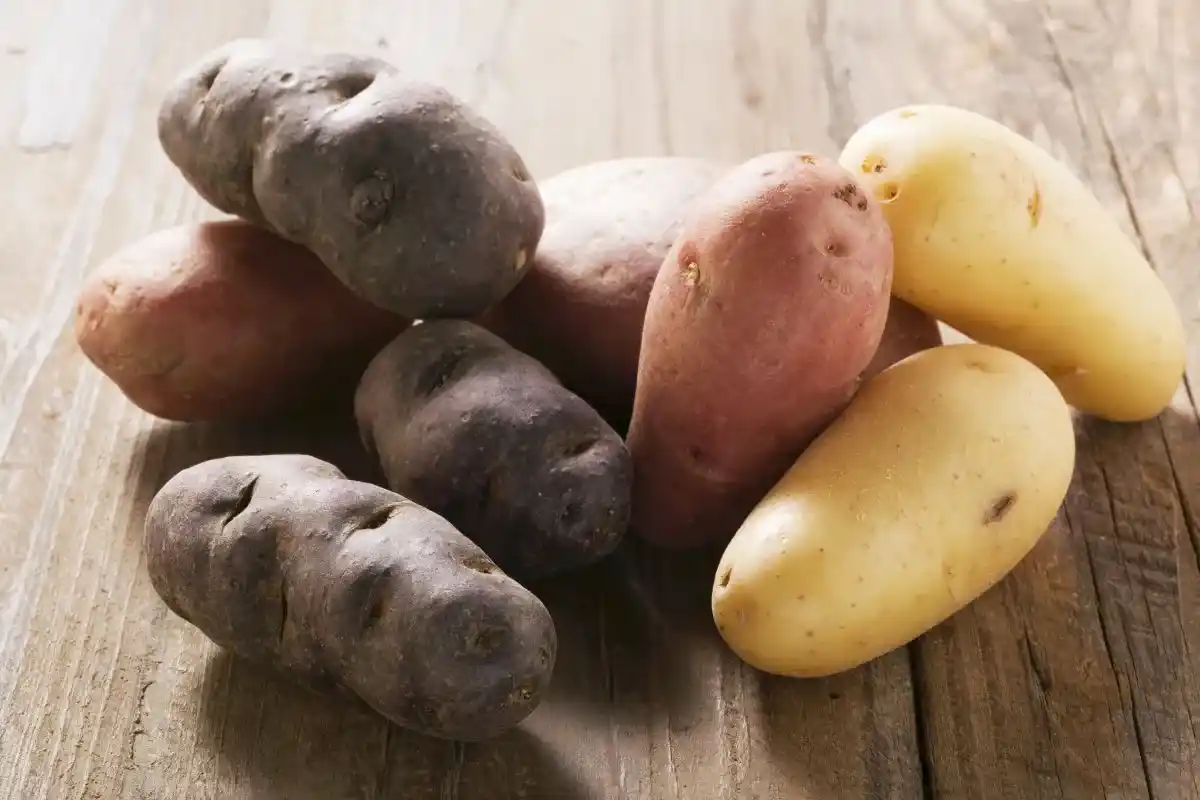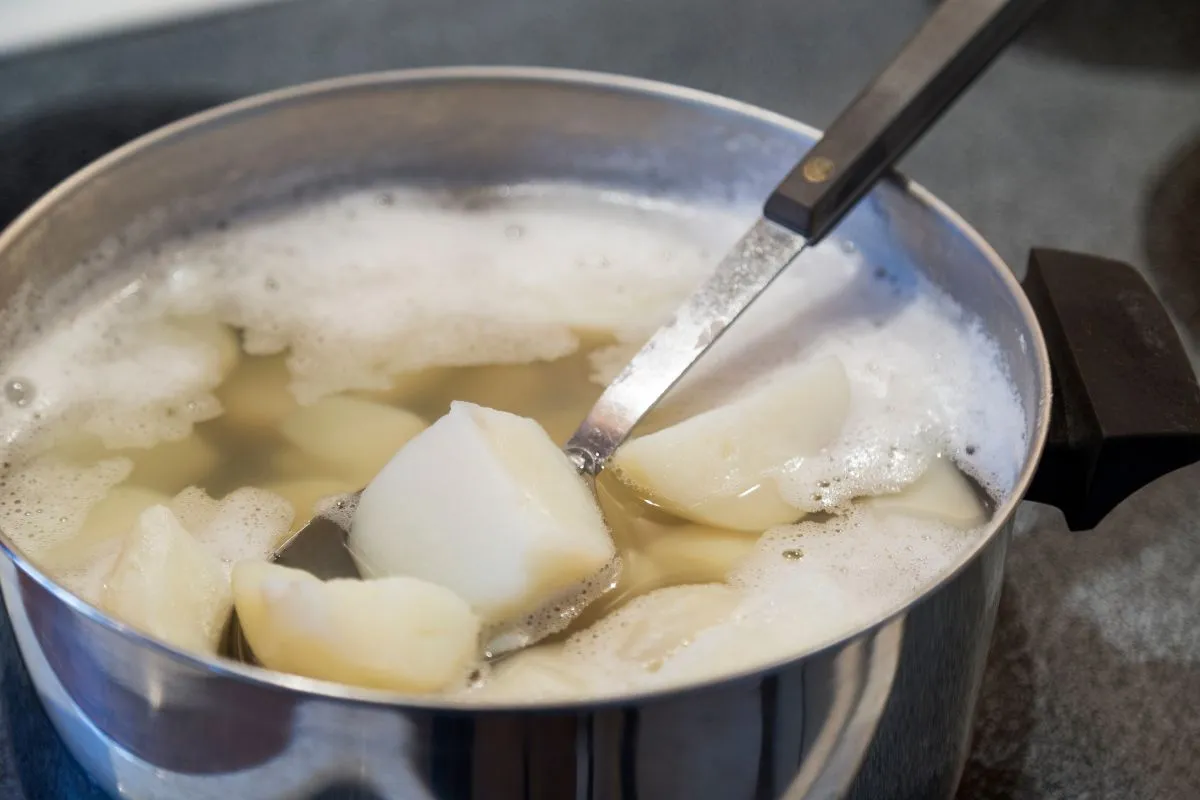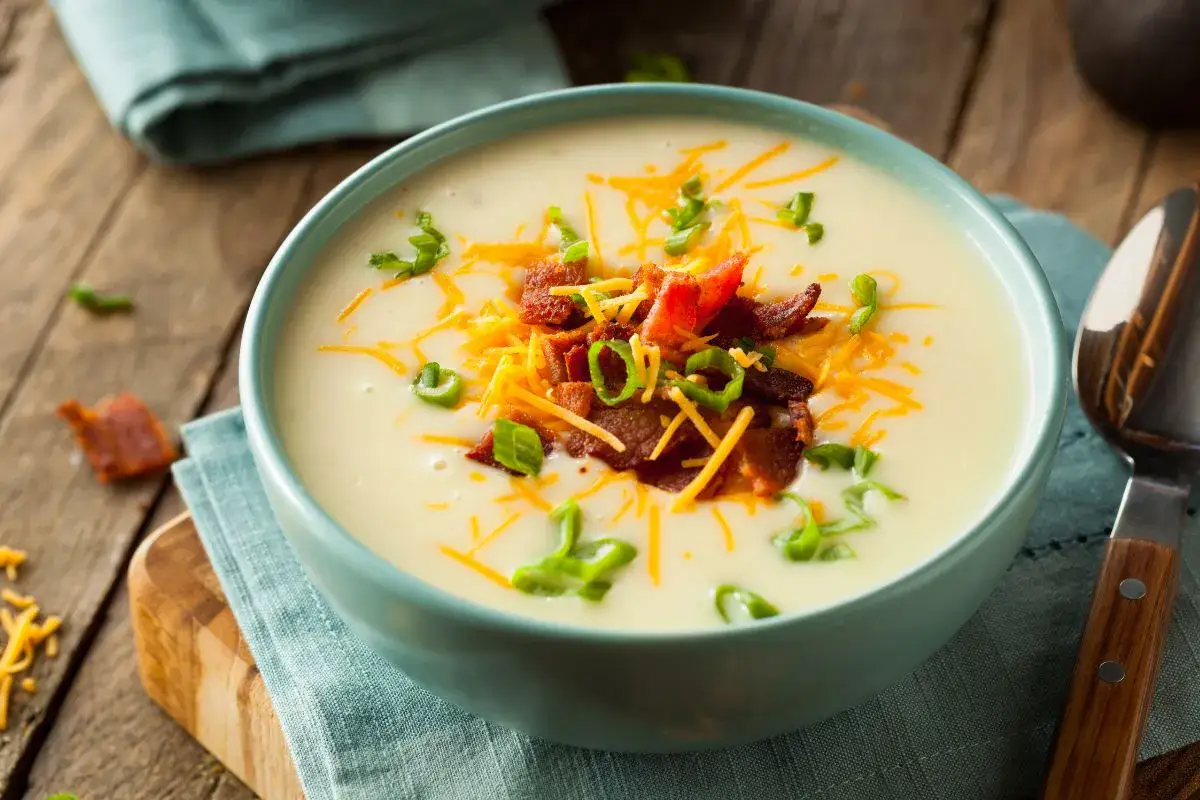Introduction to 4 Ingredient Potato Soup
In a culinary world often dominated by complex dishes and lengthy ingredient lists, the 4 ingredient potato soup stands out as a beacon of simplicity and comfort. This dish embodies the principle that less truly can be more, especially when it comes to creating warm, comforting meals that soothe the soul and please the palate with minimal fuss.
The Simplicity and Comfort of Potato Soup
Potato soup, at its core, is a testament to the beauty of simplicity. Made with just potatoes, milk, green onions, and garlic salt, this soup proves that you don’t need a pantry full of ingredients to create a dish that’s rich in flavor and texture. The 4 ingredient potato soup is:
- Easy to prepare: With only four ingredients, preparation and cooking times are significantly reduced.
- Comforting: Its creamy texture and warm, inviting flavor make it the perfect comfort food.
- Versatile: While delicious on its own, it can also serve as a base for adding other ingredients if desired.
The Appeal of Minimal Ingredient Recipes
Minimal ingredient recipes like the 4 ingredient potato soup are gaining popularity for several reasons:
- Accessibility: Fewer ingredients mean these recipes are more accessible to novice cooks and those with limited pantry supplies.
- Affordability: With less to buy, these dishes are kind to your grocery budget.
- Healthier options: Simpler recipes often rely on whole, unprocessed ingredients, making for healthier meal options.
Why Choose 4 Ingredient Potato Soup?
Choosing to make a 4 ingredient potato soup is not just about simplicity or the need for comfort food; it’s also about embracing a cooking philosophy that appreciates the value of each ingredient. This soup allows each component – the creaminess of the potatoes, the richness of the milk, the freshness of the green onions, and the subtle warmth of the garlic salt – to shine through without competition.
Tips for Maximizing Flavor
To ensure your 4 ingredient potato soup is as flavorful as possible:
- Select the right potatoes: Opt for starchy varieties like Russets or Yukon Golds for the creamiest texture.
- Enhance with toppings: Though not necessary, consider garnishing with additional green onions, cheese, or bacon bits for added flavor layers.
- Adjust seasoning carefully: Start with a conservative amount of garlic salt and adjust according to your taste preferences.
Embracing the 4 Ingredient Philosophy
Embracing the 4 ingredient philosophy encourages creativity within constraints, pushing you to make the most out of each ingredient. It teaches the importance of ingredient quality and how simple combinations can lead to the most memorable dishes. The 4 ingredient potato soup is a prime example of how a minimalist approach can lead to maximum flavor, proving that sometimes, the simplest dishes are the most satisfying.
Choosing the Right Potatoes
The choice of potato can dramatically affect the texture, flavor, and overall success of your 4 ingredient potato soup. Since the potato is the star of this dish, understanding the characteristics of different types of potatoes and their impact on your soup is essential.

Starchy vs. Waxy Potatoes
- Starchy Potatoes: Ideal for soups due to their high starch content, which contributes to a creamier texture. Russets are a prime example, breaking down easily when cooked and lending a silky smoothness to the soup.
- Waxy Potatoes: Such as Red or New potatoes, are less ideal as they maintain their shape and firmness after cooking, leading to a less creamy texture.
The Best Potatoes for Soup
- Russet Potatoes: With their fluffy texture and ability to absorb flavors, Russets are perfect for creating a smooth, creamy soup.
- Yukon Gold Potatoes: Offering a buttery flavor and a slightly creamier texture than Russets, Yukon Golds are another excellent choice for potato soup.
Tips for Selecting and Preparing Potatoes
- Choose Potatoes Carefully: Look for potatoes that are firm, with no green spots or sprouts.
- Preparation: Peel the potatoes for a smoother soup, or leave the skin on for added texture and nutrients.
- Cutting Size: Cut the potatoes into uniform pieces to ensure even cooking.
Why Potato Choice Matters
The right type of potato can enhance the 4 ingredient potato soup by:
- Improving Texture: A creamy texture is key to a great potato soup. Starchy potatoes break down during cooking, thickening the soup naturally.
- Enhancing Flavor: Potatoes are not just about texture; they also absorb the flavors of the milk, green onions, and garlic salt, distributing these tastes throughout the dish.
- Cooking Time: Different types of potatoes can affect cooking times. Starchy potatoes tend to cook faster when boiled, which is ideal for quick and easy soups.
Experimenting with Potato Varieties
While Russets and Yukon Golds are top choices, don’t be afraid to experiment with different varieties to find your personal preference. Each type of potato can add a unique twist to the soup, allowing you to customize the dish to your liking.
Choosing the right potatoes is more than a step in the recipe; it’s a decision that influences the entire cooking process and final outcome of your 4 ingredient potato soup. By selecting the best type for your soup, you ensure a delicious, creamy, and satisfying dish that highlights the simplicity and elegance of using minimal ingredients to achieve maximum flavor.
Milk Options for Creaminess
In crafting the perfect 4 ingredient potato soup, selecting the right type of milk is crucial to achieving the desired creaminess and flavor. Milk not only adds richness but also influences the texture and overall mouthfeel of the soup.
Whole Milk: The Classic Choice
- Whole Milk: A traditional favorite, whole milk is often chosen for its rich flavor and creamy texture. It’s the go-to option for those seeking a classic, indulgent soup.
- Benefits: Offers a balance of fat and water content, contributing to a smoother, richer soup without being overly heavy.
Low-Fat and Skim Milk: Lighter Alternatives
- Low-Fat Milk: For a lighter version of the soup, low-fat milk can be used. It reduces the overall calorie count while still providing some creaminess.
- Skim Milk: The leanest option, skim milk, cuts down on calories and fat but may result in a less creamy texture. It’s ideal for those prioritizing health or dietary restrictions.
- Adjustments: To compensate for the reduced creaminess, consider blending a portion of the soup to thicken its base without added fat.
Non-Dairy Milk: Vegan and Lactose-Free Options
- Almond Milk: Offers a nutty flavor and is a popular choice for dairy-free versions of the soup. Opt for unsweetened varieties to avoid altering the soup’s taste.
- Coconut Milk: Adds a hint of sweetness and tropical flair, along with a creamy texture. Its richness closely mimics that of whole milk.
- Soy Milk: A versatile option that closely resembles the consistency of cow’s milk, making it a straightforward substitute.
Enhancing Creaminess without Compromising Flavor
- Blending: Regardless of the milk choice, blending part of the soup can help achieve a creamier texture.
- Seasoning Adjustments: Different milks may slightly alter the flavor profile. Taste and adjust seasonings accordingly to maintain a balanced flavor.
Preparing the Soup
When crafting the perfect bowl of 4 ingredient potato soup, the journey begins with simplicity and ends in culinary delight. This section breaks down the essential steps and shares tips for achieving that coveted texture, making every spoonful a testament to comfort food done right.

Step-by-Step Cooking Instructions
- Select Your Potatoes: Opt for russet potatoes due to their high starch content, which lends the soup its creamy texture. Peel and cut into uniform pieces for even cooking.
- Combine Ingredients in a Pot: In a large pot, place the potatoes, and cover them with water. Add a pinch of salt to enhance the flavors.
- Simmer to Perfection: Bring the pot to a boil, then reduce to a simmer. Cook until the potatoes are tender, usually about 15-20 minutes.
- Blend to Creaminess: Once the potatoes are cooked, remove from heat. Add milk and garlic salt, then blend with an immersion blender or masher to your desired consistency.
- Finish with Flair: Serve hot, garnished with chopped green onions for a pop of color and freshness.
Tips for Achieving the Perfect Texture
- The Right Potatoes Make a Difference: Russet potatoes are ideal for their texture and flavor. Their high starch content thickens the soup naturally, creating a velvety smooth base.
- Milk Matters: Use whole milk for the creamiest texture. For a lighter version, 2% works well without compromising too much on richness. Dairy-free? Unsweetened almond or soy milk are great alternatives.
- Consistency is Key: For a smoother soup, blend thoroughly with an immersion blender. Prefer it chunky? A simple potato masher will leave satisfying pieces throughout.
- Season to Taste: Garlic salt adds depth, but don’t hesitate to adjust according to your taste preferences. A dash of black pepper can elevate the flavors further.
Embracing these steps and tips will not only simplify the cooking process but also ensure that your 4 ingredient potato soup turns out delicious every time. Whether it’s a chilly evening or you’re just in need of some comfort food, this soup is a testament to the power of simplicity in the kitchen.
Variations and Serving Suggestions
The beauty of 4 ingredient potato soup lies in its simplicity and versatility. This section explores various ways to adapt the recipe to suit different dietary needs and preferences, along with suggestions for serving.
Dairy and Non-Dairy Variations
Creating a comforting bowl of potato soup doesn’t require strict adherence to traditional ingredients. Both dairy and non-dairy options can result in a delicious end product.
- Whole Milk: For a rich, creamy texture, whole milk is the go-to choice. Its fat content enhances the soup’s body, making each spoonful luxuriously smooth.
- Non-Dairy Milks: For those avoiding dairy, unsweetened almond, soy, or oat milk can be used. These alternatives offer a lighter texture but still provide a comforting feel. The key is to choose unsweetened and unflavored varieties to maintain the soup’s savory profile.
Vegan Substitutions
Turning the classic 4 ingredient potato soup into a vegan delight is simpler than one might think. With a few adjustments, you can create a vegan version that’s just as satisfying.
- Plant-Based Milk: Opt for almond, soy, or oat milk as a substitute for dairy milk. These options keep the soup vegan-friendly without compromising on creaminess.
- Vegan Toppings: Enhance your soup with dairy-free cheese and sour cream alternatives, or add a sprinkle of nutritional yeast for a cheesy flavor without the cheese.
Lower Calorie Options with Cauliflower
For those watching their calorie intake, incorporating cauliflower into your 4 ingredient potato soup offers a clever way to reduce calories while still enjoying a hearty meal.
- Cauliflower Blend: Replace half of the potatoes with cauliflower. This not only lowers the calorie content but also adds a nutritional boost. Cook the cauliflower alongside the potatoes, then blend as usual.
- Texture and Flavor: Cauliflower’s mild taste blends seamlessly into the soup, maintaining the comforting essence of the dish. It also helps thicken the soup, mimicking the creamy texture traditionally achieved with potatoes.
Toppings and Add-ins for Enhanced Flavor
While the base of a 4 ingredient potato soup is simple and comforting, the addition of various toppings and add-ins can transform it into a gourmet experience. These enhancements not only add complexity to the flavor but also introduce different textures, making each bite unique and satisfying.
Creative Toppings for Potato Soup
Toppings play a critical role in elevating the 4 ingredient potato soup, allowing for customization to individual taste preferences. Here are some suggestions:
- Crispy Bacon Bits: Add a smoky crunch that contrasts beautifully with the creamy soup.
- Shredded Cheese: Melts into the hot soup, adding a layer of gooey richness. Cheddar, Gouda, or smoked cheeses work wonderfully.
- Sour Cream or Greek Yogurt: Introduces a tangy creaminess, enhancing the soup’s texture and flavor depth.
- Fresh Herbs: Chopped chives, parsley, or dill can add a fresh, vibrant flavor and color contrast.
- Croutons or Toasted Bread Cubes: Offer a satisfying crunch and a way to soak up the delicious soup.
- Roasted Seeds or Nuts: Pumpkin seeds or chopped walnuts add a nutty flavor and crunchy texture.
Flavorful Add-ins
Integrating additional ingredients into the soup can further enhance its flavor profile and nutritional value. Consider these add-ins:
- Roasted Garlic: Offers a sweet and mellow garlic flavor that blends seamlessly with the creamy potatoes.
- Sautéed Mushrooms: Introduce an earthy flavor that complements the soup’s richness.
- Spinach or Kale: Adds a pop of color and boosts the nutritional content with minimal impact on the flavor.
- Spices: A pinch of paprika, cumin, or curry powder can add warmth and complexity to the soup.
- Cooked Grains: Barley or wild rice can turn the soup into a more filling meal, adding texture and substance.
Serving Suggestions and Pairings
To round out the meal, consider these serving suggestions and pairings:
Bread Options
- Crusty Bread: Serves as the perfect vehicle for scooping up the soup.
- Garlic Bread: Adds a flavorful crunch and complements the soup’s garlic notes.
Salad Pairings
- Simple Green Salad: A light, vinaigrette-dressed salad balances the creaminess of the soup.
- Apple and Walnut Salad: Offers a crunchy, sweet contrast to the savory soup.
Beverage Pairings
- White Wine: Choose a crisp, acidic white wine to cut through the richness of the soup.
- Apple Cider: A non-alcoholic option that pairs wonderfully with the earthy flavors of the soup.
And for more recipes with simple ingredients explore this delicious 3-Ingredients Ham Glaze Meal
Storing and Reheating
When it comes to 4 ingredient potato soup, ensuring that its creamy texture and comforting taste are preserved, even after storage, is crucial. This section will delve into the best practices for storing your soup and methods to reheat it without sacrificing quality.

Best Practices for Storage
To maintain the integrity of your 4 ingredient potato soup, follow these guidelines:
- Cool Quickly: Before storing, allow your soup to cool down to room temperature. Quick cooling helps prevent bacterial growth.
- Airtight Containers: Use airtight containers to store your soup. This keeps it fresh and prevents it from absorbing odors from the refrigerator.
- Portioning: Consider portioning the soup into individual servings. This makes reheating more convenient and reduces waste.
- Refrigeration: Keep your soup in the refrigerator if you plan to consume it within 3-4 days. Beyond this, freezing is recommended.
Reheating Without Losing Quality
Reheating 4 ingredient potato soup properly can help retain its creamy texture and comforting warmth. Here are tips to ensure it tastes just as good as when it was first made:
- Stovetop Method: Reheat your soup on the stovetop over low heat. Stir frequently to prevent sticking and ensure even heating. If the soup has thickened too much, a splash of milk can help restore its creamy consistency.
- Microwave Tips: For a quick option, use the microwave. Cover the soup loosely and heat in short intervals, stirring in between to evenly distribute heat.
- Avoid Boiling: When reheating, avoid bringing the soup to a boil. High heat can cause the milk to separate, affecting the soup’s texture.
- Add Freshness: Consider adding a garnish of fresh green onions or a sprinkle of cheese after reheating. This can refresh the flavors and add a touch of brightness.
By following these storage and reheating practices, you can enjoy your 4 ingredient potato soup with the same creamy texture and heartwarming taste days after making it. Whether you’re looking for a quick lunch or a comforting dinner, these tips ensure your potato soup remains a go-to favorite.
And For more tips and details on Storing and Reheating different meals explore more articles on Delicious Chef.
Frequently Asked Questions
What does potato soup contain?
A simple and comforting 4 ingredient potato soup typically contains:
- Potatoes: The base and main ingredient, providing texture and flavor.
- Milk: Adds creaminess to the soup.
- Green Onions: Offer a subtle sharpness and color.
- Garlic Salt: Enhances the overall flavor profile.
How do you thicken potato soup?
To thicken 4 ingredient potato soup, you can:
- Blend a portion of the soup and mix it back in to add creaminess without additional ingredients.
- Cook the potatoes longer, allowing them to break down naturally and thicken the soup.
- Add a dairy product like cream or sour cream for a richer texture.
What is the secret ingredient to thicken soup?
While not traditionally included in 4 ingredient potato soup, a secret ingredient to thicken any soup is:
- Cornstarch or flour: A slurry made from these can be added to the soup, thickening it without altering the flavor significantly.
What is the most important ingredient in soup?
The most important ingredient in any soup, including 4 ingredient potato soup, is often considered to be:
- The base ingredient (in this case, potatoes), as it sets the foundation for the soup’s flavor and texture.
What is the No 1 soup in the world?
The title of No. 1 soup in the world can vary based on individual tastes and cultural preferences, but a commonly revered soup is:
- French Onion Soup: Known for its rich broth, caramelized onions, and melted cheese topping, it’s a favorite among many. However, preferences vary, and some might argue that simple classics like 4 ingredient potato soup hold a special place in the hearts of soup lovers worldwide.
Conclusion
In conclusion, mastering the art of making and maintaining the quality of 4 ingredient potato soup is not only about the simplicity of its ingredients but also the care taken in its preparation, storage, and reheating. The journey from choosing the right potatoes to serving a creamy, comforting bowl is filled with small steps that make a big difference. By adhering to best practices for storage—cooling the soup quickly, using airtight containers, and opting for refrigeration or freezing—you can extend the enjoyment of your soup for days. Equally important is the reheating process, which, when done gently, can revive the soup to its original glory without compromising its texture and flavor.
Adding a touch of freshness with garnishes can also enhance the experience, making every bowl as delightful as the first. This 4 ingredient potato soup stands as a testament to the beauty of simplicity, proving that with just a few ingredients and the right techniques, you can create a dish that warms the heart and soothes the soul.


